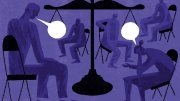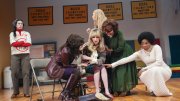"The northern hemispheres were almost black from dirt," says David A. Cobb, head of the Harvard Map Collection, referring to a terrestrial globe and a celestial globe -- made in 1541 and 1551, respectively, by Flemish cartographer Gerard Mercator -- and how they looked before their conservation, a procedure that took 18 months. Restored and wonderful to see, the globes are on display at the collection, in Pusey Library, or may be examined and virtually twirled at https://hcl.harvard.edu/mercatorglobes.
 |
 |
| |
Mercator was a pathfinder who devised a way to make globes commercially by (relative) mass production. He abandoned the earlier practice of engraving a map directly on a solid sphere of wood or metal. Each Mercator globe is hollow, made of papier-mâché molded around a wooden sphere, cut from the form along the equator, reassembled, and coated with thin layers of plaster. He then covered the globe with 12 engraved paper gores that narrowed toward the poles and two calottes (circular caps) covering the poles. He colored the engravings by hand and set the globe into an innovative stand with horizon rings.
Mercator's terrestrial globe was up to date and showed North America as a separate continent. His celestial globe was based on Ptolemy's star system but also recognized recent findings by Copernicus. The globe shows the celestial sphere from the outside. Mortal stargazers imagined the figures in Mercator's 50 constellations facing inward, which is why Sagittarius, at top, is shown from the rear. Scorpius appears to the right of the archer from our inside perspective, but here is at left.
Mercator issued only these two globes, and although he is thought to have made several hundred of them, only 22 matched pairs are known. This is the only pair in the Americas.
The cartographer went on to discover how to translate the round earth onto a flat map. This so-called Mercator projection, produced in 1569, let navigators plot a straight course over long distances far more easily than theretofore. His influential career was capped with the posthumous publication in 1595 of the splendid Atlas sive Cosmographicae meditationes de fabrica mundi et fabricati figura, of which Harvard has a copy.
Cobb's bailiwick is the oldest map collection in the United States. It includes in the neighborhood of 400,000 maps, more than 6,000 atlases, several thousand reference books, and growing digital resources, including the Harvard Geospatial Library. This is all instructive stuff in its way, and valuable, but it is not all priceless. If you're doing some spring cleaning and come across a well-thumbed road map of Nebraska in the Forties or a street map of yesterday's Tuscaloosa, give it to Cobb. He'll treasure it.
 |
| Photographs courtesy of the Harvard Map Collection, Harvard College Library, ©President and Fellows of Harvard College |




